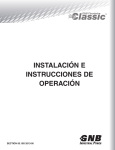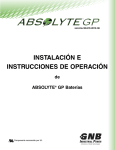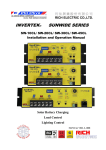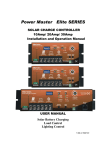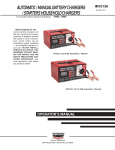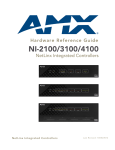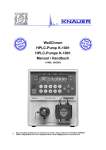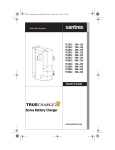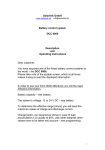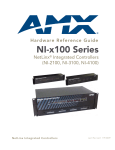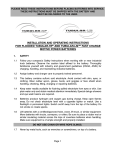Download INSTALLATION & OPERATING INSTRUCTIONS
Transcript
® INSTALLATION & OPERATING INSTRUCTIONS SECTION 93.10 2014-08 YOUR GNB REPRESENTATIVE SAlESPErSoN TElEPhoNE loCATIoN GNB SERVICE ASSISTANCE 1-800-241-4895 Page SECTION 1 1.0 General Information . . . . . . . . . . . . . . . . . . . .1 SECTION 2 2.0 Safety Precautions . . . . . . . . . . . . . . . . . . . .1 SECTION 3 3.0 receipt of Shipment . . . . . . . . . . . . . . . . . . .1 3.1 Concealed damage . . . . . . . . . . . . . . . . . . . .2 3.2 Electrolyte levels . . . . . . . . . . . . . . . . . . . . .2 SECTION 4 4.0 Storage Prior to Installation . . . . . . . . . . . . . .2 4.1 Storage location . . . . . . . . . . . . . . . . . . . . . .2 4.2 Parts and Accessories . . . . . . . . . . . . . . . . . .2 4.3 Storage Interval . . . . . . . . . . . . . . . . . . . . . . .2 4.4 dry Charged Batteries . . . . . . . . . . . . . . . . . .2 SECTION 5 5.0 rack Assembly . . . . . . . . . . . . . . . . . . . . . . .2 SECTION 6 6.0 Unpacking and handling . . . . . . . . . . . . . . . .2 SECTION 7 7.0 Installation . . . . . . . . . . . . . . . . . . . . . . . . . . .3 7.1 Battery location . . . . . . . . . . . . . . . . . . . . . . .3 7.2 Temperature . . . . . . . . . . . . . . . . . . . . . . . . . .3 7.3 Temperature variation . . . . . . . . . . . . . . . . . .3 7.4 ventilation . . . . . . . . . . . . . . . . . . . . . . . . . . .3 7.5 Placement of Cells . . . . . . . . . . . . . . . . . . . . .3 7.6 Connecting Cells . . . . . . . . . . . . . . . . . . . . . .4 7.7 Completing Installation . . . . . . . . . . . . . . . . .6 SECTION 8 8.0 Initial Charge . . . . . . . . . . . . . . . . . . . . . . . . .7 8.1 Constant voltage Method . . . . . . . . . . . . . . .7 8.2 Initial Charge-Electrolyte levels . . . . . . . . . .7 SECTION 9 9.0 operation . . . . . . . . . . . . . . . . . . . . . . . . . . . .7 9.1 Floating Charge Method . . . . . . . . . . . . . . . .7 9.2 Float Charge-Float voltages . . . . . . . . . . . . .7 9.3 voltmeter Calibration . . . . . . . . . . . . . . . . . . .8 9.4 Cycle Method of operation . . . . . . . . . . . . . .8 9.5 recharge . . . . . . . . . . . . . . . . . . . . . . . . . . . .8 SECTION 10 10.0 Equalizing Charge . . . . . . . . . . . . . . . . . . . . .8 10.1 Equalizing Frequency . . . . . . . . . . . . . . . . . .8 10.2 Equalizing Charge Method . . . . . . . . . . . . . .9 10.3 Equalizing Individual Cells . . . . . . . . . . . . . . .9 10.4 Equalizing Charge—Electrolyte levels . . . . .9 SECTION 11 11.0 Specific Gravity . . . . . . . . . . . . . . . . . . . . . . .9 11.1 hydrometer readings . . . . . . . . . . . . . . . . .10 11.2 Correction for Temperature . . . . . . . . . . . . .10 11.3 Correction for Electrolyte level . . . . . . . . . .10 11.4 Specific Gravity range . . . . . . . . . . . . . . . .10 INDEX Page SECTION 12 12.0 Cell voltage variation . . . . . . . . . . . . . . . . . .10 12.2 Cell voltage variation–damp Covers . . . . . .11 12.2 Cell voltage–Temperature Correction . . . . .11 12.3 Correction Factor . . . . . . . . . . . . . . . . . . . . .11 SECTION 13 13.0 Pilot Cell . . . . . . . . . . . . . . . . . . . . . . . . . . . .11 SECTION 14 14.0 records . . . . . . . . . . . . . . . . . . . . . . . . . . . .11 SECTION 15 15.0 Water Additions . . . . . . . . . . . . . . . . . . . . . .12 15.1 Water Purity . . . . . . . . . . . . . . . . . . . . . . . . .12 SECTION 16 16.0 Tap Connections . . . . . . . . . . . . . . . . . . . . .12 SECTION 17 17.0 Temporary Nonuse . . . . . . . . . . . . . . . . . . .12 SECTION 18 18.0 Battery Cleaning . . . . . . . . . . . . . . . . . . . . .12 18.1 Styrene Acrylonitrile Containers with Butadiene Styrene Covers . . . . . . . . . . . . . .12 18.2 Polycarbonate Containers and Covers . . . .12 SECTION 19 19.0 Connections . . . . . . . . . . . . . . . . . . . . . . . . .13 19.1 Connection resistance . . . . . . . . . . . . . . . .13 19.2 retorquing Connections . . . . . . . . . . . . . . .13 19.3 Connection resistance Measurement . . . . .14 TABLES TABLE A . . . . . . . . . . . . . . . . . . . . . . . . . . . . . . . . .7 TABLE B . . . . . . . . . . . . . . . . . . . . . . . . . . . . . . . . .7 TABLE C . . . . . . . . . . . . . . . . . . . . . . . . . . . . . . . .8 TABLE d . . . . . . . . . . . . . . . . . . . . . . . . . . . . . . . .9 TABLE E . . . . . . . . . . . . . . . . . . . . . . . . . . . . . . . . .9 STATIONARY BATTERY MAINTENANCE REPORT . . . . . . . . . . . . . . . . . . . . . . . . . . . . . . .15 FIGURES FIGURE FIGURE FIGURE FIGURE FIGURE FIGURE FIGURE FIGURE FIGURE FIGURE FIGURE 1 . . . . . . . . . . . . . . . . . . . . . . . . . . . . . . .2 2 . . . . . . . . . . . . . . . . . . . . . . . . . . . . . . .4 2A . . . . . . . . . . . . . . . . . . . . . . . . . . . . . .5 3 . . . . . . . . . . . . . . . . . . . . . . . . . . . . . . .6 4 . . . . . . . . . . . . . . . . . . . . . . . . . . . . . . .6 5 . . . . . . . . . . . . . . . . . . . . . . . . . . . . . .10 6 . . . . . . . . . . . . . . . . . . . . . . . . . . . . . .14 7 . . . . . . . . . . . . . . . . . . . . . . . . . . . . . .14 8 . . . . . . . . . . . . . . . . . . . . . . . . . . . . . .14 9 . . . . . . . . . . . . . . . . . . . . . . . . . . . . . .14 10 . . . . . . . . . . . . . . . . . . . . . . . . . . . . .14 d. When preparing electrolyte, always pour acid into water, NEVER water into acid. Failure to follow this precaution will result in excess heat and violent chemical reaction which may cause serious injury to personnel. SECTION 1 1.0 General Information E. If electrolyte comes into contact with skin or clothing, immediately wash with water and neutralize with a solution of baking soda and water. Secure medical treatment. If electrolyte comes into contact with the eyes, wash or flush with plenty of clean water. Secure medical treatment immediately. Caution! Before proceeding with the unpacking, handling, installation and operation of this lead-acid storage battery, the following general information should be reviewed together with the recommended safety precautions. A lead-acid battery is an electro-chemical device containing electrolyte which is a dilute solution of sulfuric acid and water. This electrolyte is corrosive and can cause injury. F. lead-acid batteries, when installed, are capable of high voltage which can cause electrical shocks to personnel. All lead-acid batteries, in the course of normal operation, generate gases which could be explosive. G. Promptly neutralize and remove any electrolyte spilled when handling or installing cells. Use a baking soda/water solution (1 lb. per gallon of water) to prevent possible injury to personnel. Stationary batteries (when installed) are usually on float charge continually, unless on discharge in the event of AC failure, or on recharge following a discharge. h. Make sure that all battery connections are properly prepared and tightened to prevent possible injury to personnel or failure of system. SECTION 2 I. BATTERY WARNING STATEMENT DANGER HIGH VOLTAGE high voltages are present on most battery systems. Exercise caution and rEMovE All METAl oBJECTS FroM PErSoN when working on or around battery. J. EXPLOSIVE GASES Gases produced by battery can be explosive. do NoT SMoKE, USE AN oPEN FlAME, CrEATE AN ArC or SPArKS IN vICINITy oF BATTEry. WEAr EyE ProTECTIoN.Personnel should discharge static charges from their person to ground before working on battery. ventilate well in an enclosed space and when charging. Whenever possible, when making repairs to charging equipment and/or batteries, interrupt AC and dC circuits to reduce the possibility of injury to personnel and damage to system equipment. This is particularly important with high voltage systems (110 volts and above). NOTE: If the foregoing precautions are not fully understood, clarification should be obtained from your nearest GNB representative. local conditions may introduce situations not covered by GNB Safety Precautions. here again, contact the nearest GNB representative for guidance with your particular safety problem; also refer to applicable federal, state, and local regulations as well as industry standards. Safety Precautions A. Wear rubber apron, gloves and safety goggles (or face shield) when handling, installing, or working with batteries. This will help prevent injury due to splashing or spillage of sulfuric acid. B. Prohibit smoking. Keep flames and sparks of all kinds away from vicinity of storage batteries as liberated or entrapped hydrogen gas in the cells may be exploded,causing injury to personnel and damage to cells. C. Never place metal tools on top of cells, since sparks due to shorting across cell terminals may result in an explosion of hydrogen gas in or near the cells. Insulate tool handles to protect against shorting. Familiarize personnel with battery installation, charging and maintenance procedures. restrict access to battery area, permitting trained personnel only, to reduce the possibility of injury. K. When maintaining a connected battery string, care must be taken to prevent a build-up of static charge. This danger is particularly significant when the worker is electrically isolated, ie. working on a rubber mat or an epoxy painted floor or wearing rubber shoes. Prior to making contact with the cell, discharge static electricity by touching a grounded surface. Wearing a ground strap while working on a connected battery string is not recommended. ACID BURNS Battery contains SUlFUrIC ACId WhICh CAN CAUSE SEvErE BUrNS. Avoid getting in eyes, on skin, or on clothing. In case of contact, flush immediately and thoroughly with clean water. oBTAIN MEdICAl ATTENTIoN. 2.0 Exercise care when handling cells. When lifting straps and strap spreaders are provided, use them with appropriate mechanical equipment to safely handle cells and avoid injury to personnel. SECTION 3 3.0 Receipt of Shipment Immediately upon delivery by the carrier, examine for possible damage caused in transit. damaged packing material or staining from leaking electrolyte would indicate rough handling. 1 If such conditions are found, make description notation on delivery receipt before signing. If cell damage is found, request an inspection by the carrier and file a damage claim. Also notify local GNB representative of action taken. Storage beyond the above stated periods can result in sulphated plates which can be detrimental to battery life and performance. The battery should be given its initial charge (see Section 8.0) before the end of the above stated storage intervals and repeated for each additional storage interval. 3.1 Concealed Damage If permanent installation is deferred for an extended time period, the battery may be temporarily connected and maintained on a floating charge (see Section 9). Shortly after receipt (within 15 days), examine all cells for concealed damage. Pay particular attention to packing material exhibiting damage or electrolyte staining. Perform examination prior to installation and disposal of packing materials. Cells with electrolyte levels more that 1/2" below top of plates have suffered probable permanent damage due to plate exposure to air. If this condition or other cell damage is found, request an inspection by the carrier immediately and file a concealed damage claim. Examine cells for container damage, misaligned elements, broken plates, or any other visible damage. Failure to charge in accordance with the above can void the battery's warranty. 4.4 Dry-Charged Batteries For batteries shipped dry-charged, follow special handling and preparation instructions supplied as well as appropriate sections of this Manual. 3.2 Electrolyte Levels Cells are shipped with electrolyte levels about 1/8" below the high level line. during shipment, the levels drop due to the loss of gases from internal cell components. The amount of drop in level will vary with each type of cell. Electrolyte levels, when received, may range from the high level line to slightly below the low level line. If this condition exists, make no addition of electrolyte or water at this time (see Section 8.2). If certain cells have low electrolyte levels, with less than 1/2" of plates exposed to air, add battery grade sulphuric acid of the same specific gravity as the remaining cells; thus bringing low level cells up to the average level of other cells. SECTION 5 5.0 Rack Assembly Assembly of the battery rack should be completed in accordance with the GNB drawing and/or instructions included with the rack. SECTION 6 6.0 Unpacking and Handling Most cells are packed in individual corrugated cartons. Some smaller size cells are packed in a master carton containing 2 (two) or 3 (three) cells. Cartons are shipped on wood pallets. SECTION 4 4.0 Storage Prior to Installation 4.1 Storage Location If the battery is not to be installed at the time of the receipt, it is recommended that it be stored indoors in a cool, 60°F (15.6° C) to 90° F (32° C), clean, dry location. do not top load pallets or possible cell damage may occur. Storage or transport of flooded lead-acid batteries at temperatures exceeding 120°F (49°C) can cause detimental effects on plastic components and battery state of health which may void warranty. 4.2 Parts and Accessories Prior to planned installation of battery, the separately packaged parts and accessories should be opened and checked against shipping invoice for completeness. discovery of missing or incorrect parts during installation may cause delays resulting from reordering and shipment of replacements. Store parts in safe location to prevent loss. 4.3 Storage Interval For batteries shipped wet, fully-charged, the following storage intervals from date of shipment to date of installation and initial charge should not be exceeded: lead-Antimony Types: Three (3) Months lead Calcium Types: Six (6) Months 2 Figure 1 remove material holding cartons to pallets, exercising care when cutting banding material to prevent injury. If individual cells are to be moved to another location, do not remove carton at this time. Exercise caution if using a two-wheeled hand truck and, to prevent spillage of electrolyte, do not tilt cell more than 25 degrees from vertical. When cells have been brought to the installation sight, remove carton sleeve and top corrugated spacers. 7.3 Temperature Variation The location of rack arrangement should result in no greater than 5°F (2.78°C) variation in cell temperatures in a series string at any given time. If a greater variation is found, steps should be taken to correct the condition. When uniform cell temperature is maintained, the need for equalizing charges may be eliminated or reduced in frequency. do NoT lIFT CEllS By ThEIr TErMINAl PoSTS. Support the cells from the bottom when handling and unpacking. In general, units weighing less than 75 pounds are handled manually, being supported from the bottom. 7.4 Ventilation In the operation of lead-acid battery whether it be on initial charge, float charge, equalizing charge or recharge following a discharge, hydrogen and oxygen gases are produced. This results from electrolysis of the water portion of the electrolyte by the charging current. After removal of outer carton and top spacers, the cell should still be resting in the bottom corrugated tray. This tray is designed to be easily broken away to permit positioning of a lifting strap under the cell with a minimal amount of cell tilting. ventilation should be provided in the battery room or area to prevent hydrogen, liberated from the cells in service, from exceeding a 1% concentration. Concentrations above this percentage can result in an explosive mixture, which could be ignited by sparks from adjacent electrical equipment as well as accidental sparks or open flames introduced by personnel. All air moved by ventilation in the battery room or area should be exhausted into the outside atmosphere and should not be allowed to recirculate into other confined areas. A lifting strap and a strap spreader are furnished for use with mechanical lifting devices, when cells weigh 75 pounds or more. See Figure 1 which shows typical positioning of strap and spreader. large cells are provided with 2 lifting straps and a special spreader for stability in handling during installation. Always use lifting straps and spreaders, when provided, together with suitable mechanical lifting devices to prevent injury to personnel or damage to cells. 7.5 Placement of Cells It is assumed at this point that the battery rack has been assembled. Study the rack layout and wiring drawings to determine proper location of the positive and negative terminals of the battery; this will establish correct positioning of the initial cell on each rack row. Cells are normally installed with plate edges perpendicular to rack length. Platform lifts of adequate capacity to handle cell weights and dimensions may be used provided they are stable and capable of reaching needed heights and used on smooth and level floor conditions. Never slide cells across rough surfaces as severe scratching of plastic container bottom may result in stressing and rupturing of the jar with subsequent loss of electrolyte. At all times, exercise care when handling cells to prevent scratching of plastic jars and covers. Measure and mark the center of the rack stringer length. determine the number of cells to be placed in each row. When an odd number of cells are in the row, place the center of the initial cell at the center point of the rack stringer length. SECTION 7 When an even number of cells are in the row, locate the initial cells so that the center of the space between the cells coincides with the center mark of the stringer length. 7.0 Installation 7.1 Battery Location To reduce friction and facilitate the sliding of cells from platform lift into position on the battery rack, only dow Corning #111 silicone grease is permitted for use. It is recommended that the battery be installed in a clean, cool, dry location. Cells should not be exposed to heating units, strip heaters, radiators, steam pipes or sunshine through a window. Any of these conditions can cause a serious electrolyte temperature variation among cells within a battery (see Section 7.3). USE OF LUBRICANTS OTHER THAN DOW CORNING #111 SILICONE GREASE WILL VOID WARRANTY. 7.2 Temperature A battery location having an ambient temperature of 75°F (24°C) to 77°F (25°C) will result in optimum battery life. Batteries operated in high ambient temperatures will result in reduced life. Therefore, for longer life and ease of maintenance, locations having cooler ambient temperatures are recommended. The normal battery operating temperatures are between 60°F (16°C) and 90°F (32°C). DO NOT USE METAL RODS, SCREWDRIVERS, ETC. THROUGH POST HOLES TO POSITION CELLS AS THIS PRACTICE CAN CAUSE SHORTING AND POST DAMAGE AND WILL ALSO VOID WARRANTY. 3 When installing cells on the rack, start at the lower step or tier for stability and safety reasons. on cells using stainless steel bolts, washers and nuts, make sure a washer is placed between the bolt head and connector as well as between the nut and connector with the rolled edge against the connector. Never install washers between the connector and the cell post. (See figure 2A). Place cells on the rack so that the positive terminal (marked “+”) of each cell adjoins the negative terminal (marked “-”) of the next cell. The standard spacing between cells is 1/2” at the top of the jars. Adjacent cells should not touch; nor should any cell contact the metal rack supports or metal cable conduits. Check for proper alignment and 1/2” spacing between cells. Adjust cell position where necessary. This should be completed before installation of intercell connectors. CAUTION! WhEN INSTAllING TErMINAl hArdWArE do NoT PErMIT ANy ITEMS To FAll INTo CEll. IF SUCh MATErIAl rEMAINS IN ThE CEll, CoNTAMINATIoN WIll rESUlT, rEQUIrING rEPlACEMENT oF ThE CEll. Use two 1/2” thick pieces of plywood cut to cell width and 1” higher than jar height to expedite positioning of cells. Space cells by placing one piece between the first cell positioned and the next cell. In positioning the third cell, use the second piece of plywood for spacing. The first piece is removed and used for the next cell placement, etc. As intercell connectors are installed, adjust them to a level position and finger tighten hardware. After all connectors are installed, the hardware should be tightened using insulated tools as outlined in the following illustration. (Figure 2): The cell post surfaces have a coating of No-oX-Id grease or approved equal applied at the factory. do not remove any grease from posts. re-coat any surfaces that may have been exposed during handling of cells. Also closely examine factory coated post contact surfaces for presence of foreign substances which may have been introduced through handling or construction activity in the installation area. If the foregoing is noted, remove the NooX-Id grease or approved equal with paper wipers and apply a new coating. Also inspect posts for corrosion. If corrosion is found, clean posts with brass suede brush or plastic scouring pad and re-grease. QUANTITy ANd ThICKNESS oF INTErCEll CoNNECTorS 1/8” or 1/4” 1/8” FAIlUrE To oBSErvE ABovE ProCEdUrE MAy IMPAIr INTEGrITy oF ElECTrICAl CoNNECTIoN ANd CEll PErForMANCE. Figure 2 100 (M & N cells) 150 1/4” (PdQ, N & h cells) 150 Torque both the bolt head and the nut of stainless steel hardware to their prescribed torque values. Torquing only one side of either combination will not provide the desired tightness. 7.6 Connecting Cells re-torque stainless steel hardware 4 to 6 hours after initial torquing to allow for initial relaxation of connection components. refer to the cell arrangement drawing to determine the quantity, size, and correct positioning of the intercell connectors. on the “N” type cells using 1 1/4” wide connectors, the bolt holes are located off-center. Position the connector so that the lesser dimension faces downward on the cell post. Complete connecting of cells by installing necessary interrow, inter-tier or inter-rack cable connectors. do not connect battery to charger at this time. Gently clean contact surfaces only of the lead plated intercell connectors, terminal plates and cable lugs using a brass suede brush or 3M Scotch Brite scouring pad. Caution: do not use powered wire brush or course abrasives, as lead plating may be removed exposing copper. Take and record connection resistances (See Section 19.0) of cell to cell and cell to terminal (including inter level and load connections). This is particularly important on high rate applications. remake any connection that has a value more than 10% or 5 u Ω, whichever is greater. As contact surfaces of posts and connectors are cleaned, apply a thin coating of No-oX-Id grease or approved equal to these surfaces only. Starting at center of the cell row, install connectors per wiring diagram and cell arrangement drawing furnished with the battery. (d cells only) (M & N cells) 100 1/4” or two 1/8” CAUTION! TorQUE (INCh lBS). re-check to be certain that the cells are connected positive (+) to negative (-) throughout the battery string. Measure the total voltage at the battery terminals. The voltage should be equal to the number of cells times the voltage of one of the cells. Example: 60 cells times 2.05 volts = 123 volts. 4 5 dUST CAPS ElECTrolyTE WIThdrAWAl Figure 3 7.7 Figure 4 Electrolyte Withdrawal Tubes Certain calcium cells are equipped with two electrolyte withdrawal tubes which are installed in the diagonal corners of the cell. These permit the taking of specific gravity readings at a point about one-third from the top of the plates. (See Section 11.1). refer to Figure 3. Completing Installation Explosion resistant vents Certain cell sizes may have been shipped with GNB Prevent™ vent/filling funnels in place. These vents have flexible plastic caps installed for shipping purposes. These caps may be removed and discarded, or they may be left in place if the battery environment is dusty. (See Figure 3) A flexible shipping cap and shipping plug is installed on each withdrawal tube. The cap may be removed and discarded after neutralizing or left in place as dust covers. The red plug should be discarded. other cell sizes are supplied with Pre-vents which are not shipped in place. A standard screw-type vent is used for shipping purposes. If Pre-vent units were specified, they would have been packed separately with other accessories. remove the screw-type shipping vents one-at-a-time and install a Prevent unit before charging. discard the shipping vent. Plastic Numerals (See Page 16) Plastic cell numerals and battery terminal polarity labels are provided for 12-cell batteries of 40 ampere hours and over. The positive terminal cell is usually designated as cell #1 in the series string. other cell types are supplied with separate explosion resistant vents installed at time of shipment. Separate plastic filling funnels are supplied along with this type vent. These funnels also have flexible plastic shipping caps. here again, these may be removed and discarded or left in place if environment is dusty. Battery-to-Charger Connection The positive (+) terminal of the battery should be connected to the positive (+) terminal of the charger and the negative (-) terminal of the battery to the negative (-) terminal of the charger. The Pre-vent assembly and other explosion resistant vents are designed to prevent external sparks or flames from igniting and exploding internal cell gases. (See Figure 4). Battery Warning Statement and Nameplate (See Page 1) CAUTION! BEForE dISPoSING oF FlEXIBlE PlASTIC CAPS or SCrEW-TyPE ShIPPING CAPS, NEUTrAlIZE ANy ElECTrolyTE oN ThEM IN A BAKING SodA - WATEr SolUTIoN To PrEvENT INJUry To ANyoNE hANdlING ThESE dISCArdEd ITEMS. 6 A nameplate is shipped with the parts for each battery system. It has a peel-off backing to allow mounting on or near the battery. Nameplate information should be completed by the installer at the time of the initial charge and start of battery operation. The installer must make the contents of the Battery Warning Statement known to all personnel in the vicinity of the battery. TABLE B SECTION 8 8.0 Initial Charge Batteries lose some charge during shipment as well as during the storage period prior to installation. The battery should be installed and given its initial charge as soon after receipt as possible. At the completion of initial charge, record voltage and specific gravity of each cell while still on charge and retain records for future reference per Section 14.0. 8.1 Cell volts 2.24 2.27 2.30 2.33 2.36 2.39 2.42 2.45 2.48 2.50 Constant Voltage Method Constant voltage is the principal method to give the initial charge, as most modern chargers are of the constant voltage design. In addition, some systems have equipment with voltage limitations making the use of constant current charging undesirable. determine the maximum voltage that may be applied to the system equipment. The voltage divided by the number of cells connected in series will establish the maximum voltage per cell that may be used. 8.2 For lead-antimony types, refer to Table A and for lead-calcium types refer to Table B to obtain various voltages and associated time periods recommended. Select the highest voltage the system will allow, to perform the initial charge in the shortest period of time. — — — — 400 267 182 125 83 60 Initial Charge — Electrolyte Levels SECTION 9 INITIAL CHARGE recommended voltages and Time Periods 9.0 Operation 9.1 Floating Charge Method 9.2 Float Charge — Float Voltages In this type of operation, the battery is connected in parallel with a constant voltage charger and the critical load circuits. The charger should be capable of maintaining the required constant voltage at battery terminals and also supply a normal connected load were applicable. This will then sustain the battery in a fully charged condition and also make it available to assume the emergency power requirements, in the event of an AC power interruption or charger failure. TABLE A lead-Antimony Types NOTE: Time Periods listed in tables A and B are for cell Time-hrs 1.250 sp. gr. — — — 146 129 97 73 54 36 30 temperatures from 70°F (21°C) to 90°F (32°C). For temperatures 55°F (13°C) to 69°F (20.5°C) double the number of hours. For temperatures 40°F (4°C) to 54°F (12°C) use four times the number of hours. — — — 333 235 160 108 73 55 44 Time-hrs. 1.300 sp. gr. removal of electrolyte during the initial charge with subsequent restoration with water of levels which have fallen following placement on float charge mode could result in variations or sub-normal specific gravity values. The recommended time periods are considered minimum. raise the voltage to the maximum value permitted by the system equipment. When charging current has tapered and stabilized (no further reduction for 3 hours), charge for the hours shown in the appropriate table and for the battery temperature, at the time of stabilization, until the lowest cell voltage ceases to rise. Monitoring of cell voltages should be started during the latter 10% of the applicable time period to determine lowest cell in battery. Cell volts 2.24 2.27 2.30 2.33 2.36 2.39 2.42 2.45 2.49 2.50 444 333 210 148 100 67 48 38 36 32 Time-hrs. 1.250 sp. gr. during the initial charge, there will be an increase in the electrolyte levels and they may go above the high level mark. (See Section 3.2). This is due to gases, that were lost during transportation or standing in storage, being restored to the cells. do not remove any electrolyte even though levels may be above high level. When battery is placed on floating charge (See Section 9.2). the electrolyte levels should return close to the high level line. Establish whether the battery is of lead-antimony or leadcalcium construction by referring to type on cell name plate and compare this with the proper GNB sales literature. Time-hrs. 1.215 sp. gr. 200 150 120 90 75 60 — — — — lead-Calcium Types Time-hrs. 1.215 sp. gr. The following are the float voltage ranges recommended for the various types of batteries. Select any “volts per cell” value within the range listed that will result in the series string having an average volts per cell equal to that value. do not interchange voltage ranges from one type to another. 7 When the cell voltage reaches 2.33, the charge rate should be reduced to the normal finish charge rate. The finish charge rate is defined as amperes equal in numerical value to 5% of the cell’s 8-hour capacity in ampere hours. For example, if the cell has an 8-hour capacity of 1680 Ah, its finish rate is 84 amperes. The charge should be stopped when the specific gravity is ten (.010) points below the normal fully charged value. TABLE C recommended Float voltages Lead-Antimony Types: Nominal 1.215 sp. gr. Nominal 1.250 sp. gr. Lead Calcium Types: Nominal 1.215 sp. gr. Nominal 1.250 sp. gr. Nominal 1.300 sp. gr. 2.15 to 2.17 vPC 2.19 to 2.23 vPC 2.17 to 2.25 vPC 2.23 to 2.33 vPC 2.28 to 2.37 vPC The battery is now available for the next discharge requirement. The battery should be given an equalizing charge monthly by continuing the regular charge until there is no increase in specific gravity of the pilot cell for three hours. when using the finish charge rate. Modern constant voltage output charging equipment is recommended for the floating charger method of operation of GNB stationary type batteries. This type of charger, properly adjusted to the recommended float voltages, together with adherence to recommended maintenance procedures, will assist in obtaining consistent serviceability and optimum life. 9.5 All batteries should be recharged as soon as possible following a discharge (within 8 hours). With constant voltage chargers, this will be accomplished automatically. however, to recharge in the shortest period of time, raise the charger output voltage to the highest value which the connected system will permit. do not exceed those voltage values listed in Table d or Table E on page 9. After the battery has been given its initial charge (see Section 8.0), the charger should be adjusted to provide the recommended float voltage (see Table C) at the battery terminals. For example, a 60-cell lead antimony battery should have 130 volts maintained at its terminals. . . 60 cells x 2.17 volts per cell (v.P.C.) = 130 volts. do not use voltages for lead-antimony types higher than shown in table C, as excessive water consumption and reduced battery life will result. SECTION 10 lead-calcium types may be floated at any of the voltage values (Table C) shown for a particular nominal specific gravity. Use the lower vPC value in the appropriate nominal specific gravity group, where system equipment voltage limitations will not permit higher values. The use of higher vPC values may make it unnecessary to give an equalizing charge. however, the use of higher float voltages where high ambient temperatures prevail may result in reduced battery life. 9.3 10.0 Equalizing Charge An equalizing charge is a special charge given a battery when non-uniformity in voltage or specific gravity has developed between cells. It is given to restore all cells to a fully charged condition using a charging voltage higher than the normal float voltage and for a specified number of hours, as determined by the voltage used. Non-uniformity of cells may result from low floating voltage due to improper adjustment of the charger or a panel voltmeter which reads incorrect (higher) output voltage. Also, variations in cell temperatures greater than 5°F (2.78°C) in the series string at a given time, due to environmental conditions or rack arrangement, can cause low cells. Voltmeter Calibration Panel and portable voltmeters used to indicate battery float voltages should be accurate at the operating voltage value. The same holds true for portable meters used to read individual cell voltages. These meters should be checked against a standard every six months and calibrated when necessary. 9.4 Recharge 10.1 Equalizing Frequency The following guidelines cover lead-antimony and leadcalcium types. recommendations not applying to all types will be so designated. A. Cycle Method of Operation This method is recommended for lead antimony type cells only. lead-calcium cells should not be cycle operated. In cycle operation, the degree of discharge will vary for various applications. Therefore, the frequency of recharging will also vary. The recharge is conducted by manually starting the charge, generally using the normal finish rate. The amount of charge necessary depends on the number of ampere hours discharge. If a shorter recharge period is desired, higher charge rates equal to the eight-hour rate of discharge may be used when the battery is more than 25% discharged and the cell voltage on charge is below 2.33 volts. An equalizing charge should be given quarterly or as required by conditions in the following paragraphs (Note: lead-calcium types at nominal 1.215 sp. gr. floated 2.20 v.P.C., to 2.25 v.P.C., nominal 1.250 sp. gr. floated at 2.27 v.P.C. to 2.33 v.P.C. and nominal 1.300 sp. gr. floated at 2.31 v.P.C. to 2.37 v.P.C. may not require equalizing charges). B. Equalize when the temperature corrected specific gravity of the pilot cell (or any cell for the quarterly reading) is more than 10 points below its full charge value. (See Section 11.2) 8 C. Equalize when the floating voltage of the pilot cell (or any cell for the quarterly reading) is below 2.13 volts (nominal 1.215 sp. gr.), 2.18 volts (nominal 1.250 sp. gr.) and 2.23 volts (nominal 1.300 sp. gr.) or more than .04 volts below the average for the battery. d. Equalize to complete a recharge of the battery in a minimum length of time following an emergency discharge. NOTE: Time periods listed in Tables d and E are for cell temperatures from 70°F (21°C) to 90°F (32°C). For temperatures 55°F (13°C) to 69°F (20.5°C) double the number of hours. For temperatures 40°F (4°C) to 54°F (12°C) use four times the number of hours. E. If accurate quarterly records are maintained (See Section 14.0) and the individual cell voltages and teperature corrected specific gravities show no increase instead from the previous quarterly readings, equalizing may be deferred. (See Section 11.2) F. 10.3 Equalizing Individual Cells When only a few cells in a battery require equalizing, and system voltage limitations do not permit raising the battery voltage up to a recommended equalizing voltage, a separate voltage regulated charger may be used on the affected cells. Equalize once a year even though preceding conditions did not require. (lead-calcium types floated per paragraph A, may not require annual equalizing). 10.2 Equalizing Charge Method Constant voltage charging is the preferred method for giving an equalizing charge. determine the maximum voltage that may be applied to system equipment. This voltage, divided by the number of cells connected in series, will establish the maximum voltage per cell that may be used to perform the equalizing charge in the shortest period of time. The charger must have complete AC line isolation and should be paralleled across the below normal cell. Select the equalizing voltage values listed in Tables d or E for the type cell involved. The hours of equalizing may have to be increased from listed values before stabilization of cell voltage and specific gravity is achieved, especially where below normal condition has existed for a prolonged period. For lead-antimony types, refer to Table d and for lead-calcium type, refer to Table E to obtain various voltage and associated time period recommended. CAUTION! The recommended time periods below are considered minimum. raise the voltage to the maximum value permitted by the system equipment. When charging current has tapered and stabilized (no further reduction for three hours), charge for the hours shown in the appropriate table and for the battery temperature, at the time of stabilization, until the lowest cell voltage ceases to rise. Monitoring of cell voltages should be started during the latter 10% of the applicable time period to determine the lowest cell in battery. WhEN INdIvIdUAl ChArGEr IS rEMovEd FroM CEll WhICh hAS BEEN EQUAlIZEd, A droP IN volTAGE BEloW ThE AvErAGE STrING volTAGE MAy oCCUr. ThIS IS NorMAl, dUE To ThE EXCESS INTErNAl CEll GASES PrESENT. AS ThESE EXCESS GASES dISlodGE FroM INTErNAl CEll CoMPoNENTS, ThE CEll volTAGE WIll rISE GrAdUAlly, WhICh MAy TAKE FroM TWo To FoUr WEEKS. EQUALIZING CHARGE recommended voltages and Time Periods TABLE D lead-Antimony Types Cell volts 2.24 2.27 2.30 2.33 2.36 2.39 2.42 2.45 2.48 Cell volts 2.24 2.27 2.30 2.33 2.36 2.39 2.42 2.45 2.48 Time-hrs. 1.215 sp. gr. 80 60 48 36 30 24 — — — TABLE E lead-Calcium Types Time-hrs. 1.215 sp. gr. 222 166 105 74 50 34 — — — Time-hrs. 1.250 sp. gr. — — — 166 118 80 54 36 — Time-hrs. 1.250 sp. gr. — — — 58 51 39 29 26 24 Time-hr.s 1.300 sp. gr. — — — — 200 134 91 62 42 10.4 Equalizing Charge—Electrolyte Levels A battery which has electrolyte levels at the high level line while on a float and then placed on equalizing charge will result in a rise in electrolyte above the high level line. This is a normal condition. do NoT remove any electrolyte as the levels will return to their former condition when the battery is returned to normal float. removal of the electrolyte with subsequent restoration to proper electrolyte levels by water addition could result in variations or sub-normal specific gravity values. SECTION 11 11.0 Specific Gravity 9 In a lead-acid cell, the electrolyte is a dilute solution of water and sulfuric acid. Specific gravity is a measure of the weight of acid in the electrolyte as compared to an equal volume of water. Therefore, electrolyte with a specific gravity of 1.215 means it is 1.215 times heavier than an equal volume of water which has a specific gravity of 1.000. 11.1 Hydrometer Readings Specific gravity is used in determining a cell’s state of charge. It decreases as the cell discharges and increases as the cell is charged; reaching its original value when the cell is fully charged. Specific gravity is expressed to the third decimal place (1.215) and is measured by a hydrometer float enclosed in a glass barrel/rubber bulb syringe. draw sufficient electrolyte into the barrels holding the syringe vertical and with no hand pressure on bulb; so that float is freely floating without touching sides or top of syringe. The gravity is read on the hydrometer scale at the flat surface of the electrolyte. (See Figure 5). When taking a hydrometer reading, the base of the hydrometer syringe should be pressed firmly against the tube opening to prevent back splash of electrolyte. Fill and empty the hydrometer at least once in each cell before reading. This will give a more accurate reading of the average electrolyte density. Never inter-mix usage of hydrometers on lead-antimony or lead-calcium types as cell contamination will result. Assign hydrometers for exclusive use on one type only. 11.2 Correction for Temperature When taking specific gravity readings, corrections must be made for variations in temperature of the electrolyte. For each 3°F (1.67°C) in temperature of the electrolyte above 77°F (25°C) add one point (.001) in specific gravity to the observed hydrometer readings; and for each 3°F (1.67°C) in temperature below 77°F (25°C) subtract one (.001) in specific gravity from the observed hydrometer reading. Example: hydrometer reading 1.213 sp. gr 1.207 sp. gr. 1.204 sp. gr. Cell Temperature 68°F (20°C) 86°F (30°C) 95°F (35°C) Correction -.003 points= +.003 points= +.006 points= reading Corrected to 77°F (25°C) 1.210 sp. gr. 1.210 sp. gr. 1.210 sp. gr. 11.3 Correction for Electrolyte Level Figure 5 Clean the hydrometer glass barrel and float with soap and water as required for ease of reading and float accuracy. When recharging a lead-calcium cell, the specific gravity reading lags behind the ampere hour input due mainly to the very low end of charge currents. Mixing of the electrolyte is slow due to the small amount of gas generated; so the gravity readings do not reflect the actual state of charge. A similar condition exists after water additions. Therefore, meaningful gravity readings can only be obtained at the top of the cell after an equalizing charge or after six weeks on float. The loss of water from the electrolyte due to evaporation as well as conversion of the water to hydrogen and oxygen by charging current also effects the specific gravity value. For example: A fully charged cell with a correct high level at 77°F (25°C) will have a nominal specific gravity of 1.215. When the electrolyte level has been reduced from evaporation and charging by 1/4”, the specific gravity will be approximately 6 points (.006) higher or 1.221@ 77°F (25°C). Therefore when taking hydrometer readings, the electrolyte level referenced to the high level line should be recorded for proper evaluation of the specific gravity value. This applies when taking a pilot cell reading or for 10% of the cells when taking a quarterly set of readings. 11.4 Specific Gravity Range GNB stationary batteries are furnished with a nominal fully charged specific gravity of 1.215@ 77°F (25°C). For special applications, nominal specific gravity such as 1.250 or 1.300 @ 77°F (25°C) may be used. The specific gravity may range± .010 points within a battery for any of the nominal values @ 77°F (25°C) with the electrolyte level at the high level line and still be considered satisfactory. SECTION 12 For this reason, most GNB lead-calcium cells have elec12.0 Cell Voltage Variation trolyte withdrawal tubes to permit sampling of the electrolyte at a point one third down from the top of the plates. A long The tabulation on the following page indicates the normal cell rubber tip on the hydrometer is inserted into the tube to provoltage variation that may exist with the battery on float and vide an average value of cell specific gravity and a more no greater than a 5°F (2.78°C) variation in cell temperature. accurate indication on the state of the charge. 10 NORMAL VOLTAGE RANGE Type Lead-Antimony Nominal 1.215 sp. gr. Nominal 1.250 sp. gr. Lead-Calcium Nominal 1.215 sp. gr. Nominal 1.250 sp. gr. Nominal 1.300 sp. gr. Average Float voltage A slight amount of electrolyte may be lost each time a specific gravity reading is taken, even though it is recommended that all electrolyte in the hydrometer be returned to the cell after reading. Therefore it is suggested that the pilot cell be changed to another cell annually to provide a representative specific gravity indicator for the battery. variation 2.15 to 2.17 v.P.C. 2.19 to 2.23 v.P.C. ± .04 v.P.C. ± .04 v.P.C. 2.17 to 2.25 v.P.C. 2.23 to 2.33 v.P.C. 2.28 to 2.37 v.P.C. ± .05 v.P.C. ± .05 v.P.C. ± .05 v.P.C. SECTION 14 14.0 Records A complete recorded history of the battery operation is required. Good records will also show when corrective action may be required to eliminate possible charging, maintenance or environmental problems. 12.1 Cell Voltage Variation Damp Covers Cell voltage variation can also be the result of damp cell cover tops. Spilled electrolyte when taking hydrometer readings can result in parasitic currents paths across the tops of cell covers. This reduces the float current through the cell resulting in voltage variations. See Section 18.0 - Battery Cleaning —to correct damp cover condition. data should be recorded on Stationary Battery Maintenance report shown on page 15. report headings should be filled in completely on the date of installation. The following data should be read and permanently recorded for review by supervisory personnel. 12.2 Cell Voltage Temperature Correction A. Upon completion of the initial charge and with the battery floating at the desired float voltage for one week, read and record individual cell voltages, connection resistances, specific gravities [corrected to 77°F (25°C)], ambient temperature plus cell temperatures and electrolyte levels for 10% of the cells. The cell temperature readings should be from each step or tier of the rack to reflect temperature range of the battery. To properly analyze cell uniformity within the string, cell voltages should be corrected for cell electrolyte temperature. Cell voltage variation that may have developed since a previous quarterly set of readings may be due to cell temperature variations within the string that may have resulted from a change in ambient conditions. Therefore, correcting cell voltage for cell temperature may make it unnecessary to apply an equalizing charge which otherwise had been believed necessary. See Section 10.1 Equalizing Frequency. This first set of readings will be the basis for comparison with subsequent readings to reflect possible operating problems and the need for corrective action. 12.3 Correction Factor B. Monthly - observe the general appearance and cleanliness of the battery. record battery terminal voltage. Check electrolyte levels and adjust if necessary. Check for cracks in cells and leakage. Note any evidence of corrosion at terminals and connectors. record pilot cell voltage, specific gravity and temperature. The temperature correction factor for cell voltage equals 0.003 volts for each degree fahrenheit (0.0055v/C°) using a base 77°F (25°C). The correction is added to the measured cell voltage above 77°F (25°C) and subtracted below 77°F (25°C). Example: Measured cell voltage = 2.19v @ 87°F(30.5°C) cell temperature. Correction = 10°F x .003v (3.5°C x .0055v) = .03v. Therefore, corrected cell voltage = 2.19v + .03v = 2.22 volts. C. Quarterly - Supplement the monthly inspection and record keeping with these additional measures. Check and record the specific gravity and voltage of each cell. Check and record the electrolyte temperature of one cell on each level of individual racks. If the cell temperature in the example had been 67°F (19°C), the correction would be .03 volts which is subtracted from the measured voltage of 2.19v. The corrected cell voltage = 2.19v .03v = 2.16v. d. Annual - Supplement quarterly reports with these extra procedures. Make a detailed visual inspection of each cell. Tighten all bolted connections to the specified torque values. Take and record connection resistances of each cell to cell, cell to terminal, inter-level and load connections. remake any connections that are more than 20% above installation base value. Check integrity of the rack. SECTION 13 13.0 Pilot Cell A pilot cell is selected in the series string to reflect the general condition of all cells in the battery regarding specific gravities, float voltage and temperature. It serves as an indicator of battery condition between scheduled overall individual cell readings. E. Any time the battery is given an equalizing charge (see Section 10.1), an additional set of individual cell readings 11 should be taken after battery has been returned to normal float for one week. These will serve as an updated basis for comparison with future readings. F. SECTION 16 16.0 Tap Connections It is not recommended that tap connections be used on a battery, as possible unbalance between groups of cells may result. This can cause overcharging of the untapped group of cells and undercharging of the tapped cells supplying the load. This condition can cause unsatisfactory operation and reduced battery life. record dates of any equalizing charges as well as total quantity of water when added. Also record any maintenance and/or testing performed. The foregoing frequency of record taking may have to be modified somewhat to suit local requirements. SECTION 17 See Page 16 for Battery nameplate 17.0 Temporary Nonuse SECTION 15 An installed battery that is permitted to stand idle for a period of time should be treated in the following manner. With the battery on normal float, add approved water to cells to bring electrolyte level to the high level line. Give the battery an equalizing charge per Section 10.2. Following completion of the equalizing charge, open connections at the battery terminals to separate charger and load circuit from battery. 15.0 Water Additions There are two conditions in the operation of batteries which cause a reduction in the amount of water in the electrolyte, resulting in a lowering of the electrolyte level. These are normal evaporation and the conversion of water into hydrogen and oxygen gases by the charging current. These gases are liberated through the cell vents. Periodically, this water loss must be replaced with approved or distilled water to maintain the electrolyte level at the mid point between the high and low level lines. Every three months for lead antimony and every six months for lead calcium, temporarily connect battery to charger and give it an equalizing charge. To return to normal service, re-connect all open connections, give equalizing charge and then return battery to normal float voltage. If suitability of the local water supply for use in storage batteries is questionable, contact your nearest GNB representative for instructions regarding procedure for submitting a sample for analysis. A report will be rendered as to whether or not the water is suitable. SECTION 18 If water is to be stored in containers they should be clean and of non-metallic material; such as: glass, hard rubber, porcelain or plastic. 18.0 Battery Cleaning CAUTION Infrequently used water lines should be purged to remove accumulated impurities, thus preventing their introduction into the battery. do NoT ClEAN PlASTIC CEll JArS or CovErS WITh SolvENTS, dETErGENTS, oIlS or SPrAy TyPE ClEANErS, AS ThESE MATErIAlS MAy CAUSE CrAZING ANd CrACKING oF ThE PlASTIC MATErIAlS Water additions should be scheduled prior to an equalizing charge so that mixing with the electrolyte occurs. Also at unheated installations, arrange water additions when battery temperature is above 50°F (10°C). Never introduce “battery additives” into a GNB battery. 18.1 Styrene Acrylonitrile Containers with Butadiene Styrene Covers and PVC Containers and Covers 15.1 Water Purity The maximum allowable limits of impurities in the water used in GNB stationary batteries shall be as follows: Total solids Fixed solids organic & volatile matter Iron as Fe Manganese as Mn Nitrates as N02 Ammonia as Nh4 Chlorides as Cl Periodically, clean cell jars and covers with a water dampened cloth to remove accumulated dust. Cell parts damp with electrolyte should be neutralized with baking sodawater solution (1 lb. of soda per gallon of water). Apply with cloth dampened with the solution, making sure none is allowed to enter the cell. Continue to neutralize until fizzing action ceases, then wipe area with a water dampened cloth to remove soda solution. Wipe dry with a clean cloth. 500 ppm 350ppm 200ppm 4.0 ppm 0.007 ppm 15.0 ppm 5.0 ppm 25.0 ppm distilled water or deionized water satisfying the above requirements may be used. 18.2 Polycarbonate Containers and Covers 12 Cells with containers and covers made from polycarbonate plastic should be cleaned oNly with a WATEr dampened cloth. Any surface that is damp with electrolyte should be neutralized with a baking soda—water solution (1 lb. of baking soda per gallon of water). do NoT USE AMMoNIA, SodIUM hydroXIdE or ANy STroNG AlKAlIES. resistance measurements or microhm measurements should be taken at the time of the installation and annually thereafter. Initial measurements at installation become the benchmark values and should be recorded for future monitoring of electrical integrity. Specific values of connection resistance vary with cell type, quantity of connectors, etc. It is important that the benchmark value for all similar connections should be no greater than 10% or 5 microhms, whichever is greater, above the average resistance of all such connections in the battery. If any connection resistance exceed the average by more than 10% or 5 microhms, whichever is greater, the connection should be remade so that an acceptable benchmark value is established. Benchmark values for connection resistances should also be established for terminal plates, where used, as well as cable connections. Benchmark values should preferably be established upon installation. however, if that was not done, they may be established later provided the special procedure described below is followed. SECTION 19 19.0 Connections Battery terminal connections should be corrosion free and tight to provide satisfactory operation while supplying emergency power and when on floating charging. visual monitoring of all connections should be made quarterly. When corrosion is observed on any connection, do NoT retorque. retorquing does not improve electrical integrity but only restores mechanical compression. Any connection suspected of having corrosion should be disassembled, cleaned and neutralized. All post contact surfaces, intercell connectors, terminal plates, cable lugs and hardware should be neutralized using a solution of baking soda (1 lb./gallon water). After allowing to dry, all contact surfaces should be burnished using 3M Scotch Brite scouring pads or a brass suede brush. Stubborn oxidized coatings on solid lead parts may be removed using a narrow paint scraper. disconnect the battery from the charger and load and disassemble at least three (3) of the intercell connections. Clean, neutralize and burnish these connection components as though they had corrosion (See Section 19.0) reassemble each connection per Section 7.7 and determine its resistance. Measure the resistance of all similar connections in the battery. If any connection resistance exceeds the average of the three remade connections by 10% or 5 microhms, whichever is greater, that connection should be remade to establish an acceptable benchmark value. CAUTION! 1 DO NOT USE PoWEr WIrE BrUSh AS ThIS MAy rEMovE lEAd PlATING EXPoSING CoPPEr or CAUSE rIPPlING oF lEAd CoNTACT SUrFACES. All benchmark values should be recorded. Annually, all connection resistances should be remeasured. Any connection which has a resistance value more than 20% above the benchmark value should be corrected. 2.. DO NOT USE PAINT SCrAPEr oN PoSTS WITh CoPPEr INSErTS. INTErCEll CoNNECTorS or TErMINAl PlATES AS lEAd PlATING WIll BE rEMovEd EXPoSING CoPPEr. Increase in connection resistance of more than 20% above the recorded benchmark definitely indicates a degrading connection. Such degradation may be caused by corrosion (See Section 19.0) or by relaxation in hardware torque value. If there is no sign of corrosion, the higher resistance at the connection may be corrected by retorquing (See Section19.2). If connection resistance is reduced to within 20% of the benchmark value, no further action will be necessary. Failure to restore resistance to an acceptable value will necessitate reworking the connection. After contact surfaces are burnished, a thin coating of NooX-Id grease should be applied to all contact surfaces and hardware. The connectors and hardware should then be reassembled and torqued per Section 7.6 - Connecting Cells. It is important that properly prepared contact surfaces be coated with a thin film of No-oX-Id grease to reduce possibility of oxidation or corrosion. Tests reveal that this will also prevent measurable increase in the connection resistance. Maintaining electrical integrity of connections is important as poor connection will result in reduced battery output and in extreme cases may cause melted cell posts, circuit interruptions or battery fires. 19.1 Connection Resistance 19.2 Retorquing Connections Electrical integrity of connections can be objectively established by measuring the resistance of each connection. These resistances are typically in the microhm range. Meters are available which determine connection resistance in microhms by measuring voltage drop upon the application of a fixed direct current (dC) through the external cell connections. Some precautions must be observed to get consistent and meaningful values, however, and these are described in Section 19.3. retorquing of connections should be performed annually (See Section 9, 14) and when connection resistances have increased to more than 20% over the benchmark. retorquing should not be done if visual inspection shows evidence of corrosion. retorquing when corrosion is present only restores mechanical compression but will not improve electrical integrity. 13 Tests reveal that a reduction in the original torque value of 30% still provides a functional electrical connection if there is no corrosion between contact surfaces. (iv) Four Post, Two Connector Staggered Hook-Ups. (Figure 9). retorquing of connections should always be to the recommended value (See Section 7.7). CAUTION! Too FrEQUENT rETorQUING oF CoNNECTIoNS IS NoT rECoMMENdEd AS ThIS WIll rESUlT IN dISTorTIoN oF CEll PoSTS, CoNNECTorS, ETC., ThUS DEGRADING rAThEr ThAN IMProvING ThECoNNECTIoNS. (v) 19.3 Connection Resistance Measurements Connection resistances are very small, usually in microhms. Therefore, precautions must be observed so that the measured values are meaningful and not misleading. different connector hook-ups require that the measurement technique allows for these differences. (i) Single Connector Hook-ups. (Figure 6) When measuring the resistance of single connector hook-ups between adjacent cell posts (or in the case of flag terminals between multi-cell units), the probe point locations must be at the same location for each similar type connection. If the probe part departs from the center point indicated by “X” in Figure 6, the measured resistance value can vary due to either an increase or decrease in the lead mass included in the measuring points. When conducting subsequent monitoring of connection resistance, it is important that the same probe point locations are used so that any measured increase (or decrease) is a true increase (or decrease) due to connection degradation and not due to using a different probe point location. Four Post, Connector Parallel Hook-Ups. (Figure 10) Cells arranged end-to-end have parallel current paths above and below the cell covers and require that resistance measurement make allowance for the same. The current paths above the cover are provided by the connectors and the path under the cover is provided by the busbars (shown by dotted lines in Figure 10). Most resistance meters apply 10 amperes dC to the connections being monitored. If this was done between posts A and B in Figure 10, the current will divide through the busbars between AB and Cd and the resistance value will be about half of the actual value, provided all connections are good. If the process is repeated for posts C and d and the two resistance values are compared, the difference, if any, indicates differences in the two parallel paths as well as poor connections at the post connector interfaces. A better and preferred technique is to apply the 10 amperes dC to posts A and d such that equal current paths are provided. Then, the differences in readings across AB and Cd will reflect connector interface problems in either of the two external intercell connections. Both intercell connections should be reworked as described in Section 19.0. Figure 6 Single connector hook-ups (ii) Parallel Connector Hook-Ups. (Figure 7) Parallel paths exist in this hook-up and measurement of connection resistance include all four connector post interfaces. The location of probe points is not critical here because of the existence of parallel paths. An increase (decrease) in the lead mass between post and connector interface on one side is cancelled by an equal decrease (increase) in the mass on the opposite side. Figure 7 Parallel connector hook-ups Figure 8 Four post, four connector in-line hook-ups (iii) Four Post, Four Connector In-Line Hook-Ups. (Figure 8) Cells with four post connector hook ups require two measurements to monitor all eight post-connector interfaces. Measurement is made in two steps— First between points A and C and then between points B and d. The measured values should be the same. values appreciably different (5 micrhoms or more) require reworking of connections as described in Section 19.0. Cells with four post staggered connector hook-ups require two step measurement as described above in (iii). In addition, the probe point locations for points A and d (See Figure 9) must be centered as described above in (i). Figure 9 Four post, two connector staggered post hook-ups 14 Figure 10 Four post, four connector parallel hook-ups GNB Industrial Power A Division of Exide Technologies GB-1000F 15 STATIONARY BATTERY PLASTIC CELL NUMERAL APPLICATION To insure proper adhesion of the pressure sensitive plastic cell numerals, and polarity markings supplied with your GNB Stationary Battery, the following procedure should be followed: 4. Numerals are shipped mounted on a plastic backing strip. They are easily removed by peeling back the plastic strip. Keep finger contact with adhesive backing on numeral to a minimum. 5. locate and place numeral on side of jar, being careful that there is no conflict with electrolyte level lines or side rails of SEISMIC TyPE rACKS. For clean appearance, exercise care in numeral placement so that all the numerals are in the same relative position on each cell. 1. Numerals and polarity markings should not be applied until after the cells have been installed on the rack. It is recommended that they be applied to jar surfaces only, and not to cell covers or rack rails. 2. Clean the plastic jar surface, in the area where the numeral is to be located, by using a cloth dampened with a washing soda solution. Immediately dry the area using a soft dry cloth to remove residual washing soda. CAUTION!! do not use any solvent type materials as they may cause damage to the plastic jar material. Install polarity markings on the appropriate cells in the same manner. 6. Following application of cell numerals and polarity markings, use a dry cloth to rub entire surface of each label to insure proper surface contact. Note: Design and/or specifications subject to change without notice. If questions arise, contact your local sales representative for clarification. 3. It is a general practice to designate the positive terminal cell as #1 with succeeding cells in series in ascending order. TYPICAL BATTERY NAMEPLATE A Division of Exide Technologies No. oF CEllS CAPACITy SPECIFIC GrAvITy TyPE AMPErE hrS. AT SErIAl No. GNB INDUSTRIAL POWER, Aurora, IL 60504 NOTES 16 hr. rATE GNB Industrial Power – The Industry Leader. ® GNB Industrial Power, a division of Exide Technologies, is a global leader in network power applications including communication/data networks, UPS systems for computers and control systems, electrical power generation and distribution systems, as well as a wide range of other industrial standby power applications. With a strong manufacturing base in both North America and Europe and a truly global reach (operations in more than 80 countries) in sales and service, GNB Industrial Power is best positioned to satisfy your back up power needs locally as well as all over the world. Based on over 100 years of technological innovation the Network Power group leads the industry with the most recognized global brands such as ABSolyTE®, GNB® FloodEd ClASSIC®, MArAThoN®, rElAy GEl®, SoNNENSChEIN®, and SPrINTEr®. They have come to symbolize quality, reliability, performance and excellence in all the markets served. GNB Industrial Power takes pride in its commitment to a better environment. Its Total Battery Management program, an integrated approach to manufacturing, distributing and recycling of lead acid batteries, has been developed to ensure a safe and responsible life cycle for all of its products. GNB Industrial Power USA – Tel: 888.898.4462 Canada – Tel: 800.268.2698 www.gnb.com SECTION 93.10 2014-08 A Division of Exide Technologies





















